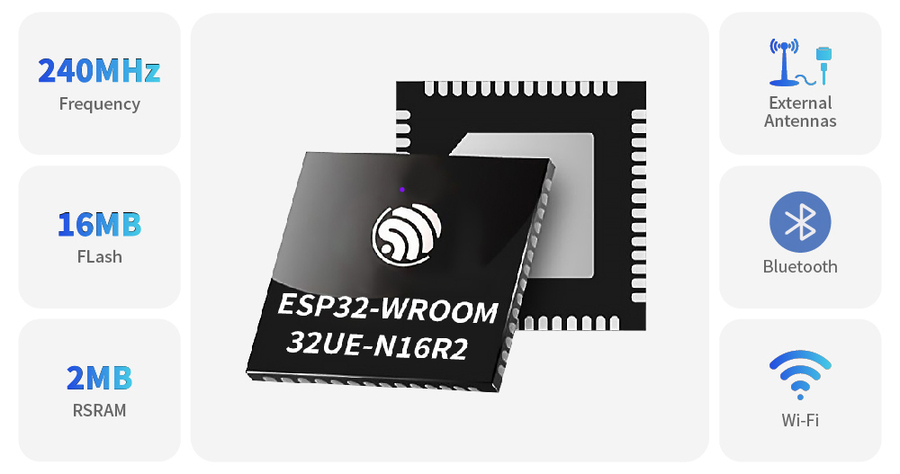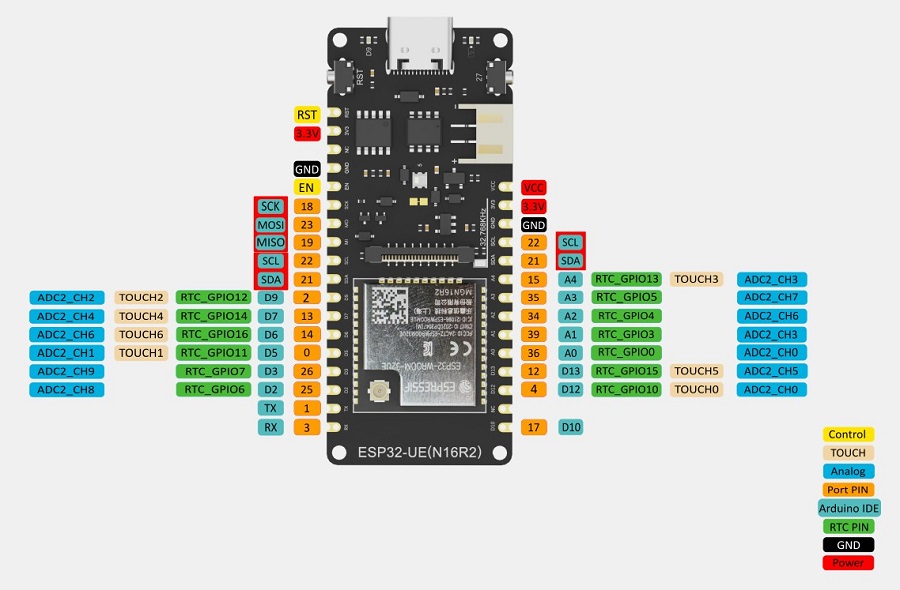FireBeetle 2 ESP32-UE (N16R2) IoT Microcontroller (16MB / 2MB PS, Supports Ext Antenna, Wi-Fi & Bluetooth) - แท้จาก DFRobot









| รหัสสินค้า | BA00299 |
| หมวดหมู่ | WiFi ESP32-C6 |
| ราคา | 885.00 บาท |
| สถานะสินค้า | พร้อมส่ง |
| จำนวน | ชิ้น |
รายละเอียดสินค้า



- Equipped with ESP32-WROOM-32UE-N16R2 dual-core module
- Clock frequency up to 240MHz, with 16M Flash and 2M PSRAM for large memory capacity- Supports external Bluetooth & WiFi antennas
- Low-power development board, supporting dual-mode communication of WiFi and Bluetooth
- Onboard GDI display interface for quick connection to display screens
- Onboard charging circuit and PH2.0 lithium battery interface, supporting dual-power supply and automatic switching
- Supports various programming methods such as Arduino IDE, ESP-IDF, MicroPython, etc.
- Compact design with small size, suitable for IoT projects with limited space and embedded systems
- IoT project prototyping
- IoT remote control
- Remote robot control
.jpg)
SPECIFICATION
Power Parameters - Input Voltage
- USB-C interface: 5V DC
- PH2.0 interface: 3.7V Li-ion
- VCC pin: 5V DC
MCU Parameters
- Processor: Tensilica LX6 dual-core processor (one core for high-speed connectivity, one core for independent application development)
- Clock Frequency: 240MHz
- SRAM: 520KB
- ROM: 448KB
- Flash: 16MB
- PSRAM: 2MB
- On-chip Clock: 40MHz crystal oscillator, 32.768KHz crystal oscillator
Wireless Parameters
- Wi-Fi Standard: FCC/CE/TELEC/KCC
- Wi-Fi Protocol: 802.11 b/g/n/d/e/i/k/r (802.11n, up to 150 Mbps), A-MPDU and A-MSDU aggregation, supports 0.4us protection interval
- Wi-Fi Frequency Range: 2.4~2.5 GHz
- Bluetooth Protocol: Compliant with Bluetooth V4.2 BR/EDR and BLE standards
- Bluetooth Audio: CVSD and SBC audio
- Bluetooth Frequency Range: 2.4~2.5GHz
Peripheral Parameters
- Digital Pins × 17: IO0, IO1, IO2, IO3, IO4, IO12, IO13, IO14, IO15, IO17, IO18, IO19, IO21, IO22, IO23, IO25, IO26
- Analog Pins × 11: IO0, IO2, IO4, IO12, IO13, IO14, IO15, IO25, IO26, I34, I35
- UART Interfaces: ×3
- SPI Interface: ×1
- I2C Interface: ×1
- I2S Interface: ×1
- DAC Interface: ×2
- Touch Interfaces: ×7
- LED PWM Channels: ×16
- RGB_LED: WS2812
- Display Interface: GDI
Other Parameters
- Interface Compatibility: FireBeetle V2 series compatible
- Module Size: 25.4mm × 60mm
- Weight: 23.4g
- Product wiki
- Pinout
- Dimension
- Getting Started (Use for the first time)
- Arduino Tutorials Esp32-wroom-32e/32ue datasheet
- Schematic
- 2D File
- STP File
- Shell stl file
- FireBeetle 2 ESP32-UE (N16R2) IoT Microcontroller x1
- 2.4GHz WiFi and Bluetooth antenna x1
- 18pin-2.54mm Pitch Pin x1
- 18pin-2.54mm Pitch Pin Female x1
- 14pin-2.54mm Pitch Pin x1
- 14pin-2.54mm Pitch Pin Female x1
Getting Started (Use for first time)
Download Arduino IDE
-
Click to enter the official Arduino website
-
Select and download the Arduino IDE package that is appropriate for your computer OS.

7.2 Configure Arduino IDE
It is required to install ESP32 board in Arduino IDE for using FireBeetle 2 ESP32-UE(N16R2) for the first time.
-
Open Arduino IDE, click File-Preferences, as shown below

-
Click the icon circled in red in the Preferences window.

-
Add the json URL below to the newly-popped up window. There should be one URL for each line.
https://espressif.github.io/arduino-esp32/package_esp32_index.json
-
Click OK then.

-
Download SDK. Click Tools->Board>Boards Manager.

-
Enter "ESP32" in the search bar, then the SDK for esp32 will appear automatically. Click install now.

-
When the SDK installation completes, the word "installed" will appear at the position marked in red below. Close the window.

-
Select FireBeetle 2 ESP32-E development board. Click Tools-->Board-->ESP32 Arduino-->FireBeetle ESP32-E, as shown below.

-
Once you have selected the development board, connect your FireBeetle 2 ESP32-UE(N16R2) to your computer and follow the steps below for setup. Finally, select the corresponding serial port.

-
Now, the FireBeetle 2 ESP32-UE(N16R2) is configured in Arduino IDE and it's ready to go.
Arduino Tutorials
Note: FireBeetle 2 ESP32-UE(N16R2) does not have the IO16/D11 pin available. If this pin is used in the following tutorials, please modify the configuration to use another pin.
The basic tutorials (click here to jump) include tutorials on GPIO, RGB LED, serial communication, capacitive touch sensor, interrupts, I2C, SPI, and GDI.
The advanced tutorials (click here to jump) include tutorials on Deep Sleep mode, SD card, WiFi, Bluetooth, Alibaba Cloud IoT, and IFTTT.
FAQ
-
Cannot add board link to Arduino IDE?
A: First off all, make sure the Network connection is in good condition. Hope this post from Arduino helps. If that doesn't work, try replacing the board link from
https://download.dfrobot.top/FireBeetle/package_DFRobot_index.json to http://download.dfrobot.top/FireBeetle/package_DFRobot_index.json and reload it.
-
When using the SD library, the serial monitor does not show any print output or displays a connection failure after uploading the program.
A: Press RST button to reset and try again.
-
The driver is not installed automatically after plugging into the device?
A: FireBeetle 2 ESP32-UE(N16R2) uses the CH340 serial chip, which can be used without installing a driver in most devices. If you find that the driver is not automatically installed when you plug in the device, you can manually install it yourself:









วิธีการชำระเงิน
ชำระเงินค่าสินค้าโดยการโอนเงินเข้าบัญชีธนาคาร KBANK, SCB, BBL,TMB
กรุณาเก็บหลักฐานการโอนเงินของท่านไว้เพื่อแจ้งการชำระเงินด้วยค่ะ
ท่านสามารถแจ้งการชำระเงินผ่านระบบอัตโนมัติได้โดย Click Link ข้างล่างค่ะ
https://www.arduitronics.com/informpayment
ชำระเงินผ่านธนาคาร
SEARCH
CATEGORY
CONTACT US
Join เป็นสมาชิกร้านค้า
STATISTICS
| หน้าที่เข้าชม | 15,522,312 ครั้ง |
| ผู้ชมทั้งหมด | 6,025,390 ครั้ง |
| เปิดร้าน | 21 พ.ค. 2556 |
| ร้านค้าอัพเดท | 6 ธ.ค. 2568 |
TRACK&TRACE
MEMBER
- ระดับ{{userdata.dropship_level_name}}
- ไปหน้าหลักตัวแทน
- ทั้งหมด {{(order_nums && order_nums.all)?'('+order_nums.all+')':''}}
- รอการชำระเงิน {{(order_nums && order_nums.wait_payment)?'('+order_nums.wait_payment+')':''}}
- รอตรวจสอบยอดเงิน {{(order_nums && order_nums.wait_payment_verify)?'('+order_nums.wait_payment_verify+')':''}}
- รอจัดส่งสินค้า {{(order_nums && order_nums.wait_send)?'('+order_nums.wait_send+')':''}}
- รอยืนยันได้รับสินค้า {{(order_nums && (order_nums.wait_receive || order_nums.wait_confirm))?'('+(order_nums.wait_receive+order_nums.wait_confirm)+')':''}}
- รอตรวจสอบข้อร้องเรียน {{(order_nums && order_nums.dispute)?'('+order_nums.dispute+')':''}}
- เรียบร้อยแล้ว {{(order_nums && order_nums.completed)?'('+order_nums.completed+')':''}}
- ทั้งหมด {{(order_nums && order_nums.all)?'('+order_nums.all+')':''}}
- รอการชำระเงิน {{(order_nums && order_nums.wait_payment)?'('+order_nums.wait_payment+')':''}}
- รอตรวจสอบยอดเงิน{{(order_nums && order_nums.wait_payment_verify)?'('+order_nums.wait_payment_verify+')':''}}
- รอจัดส่งสินค้า {{(order_nums && order_nums.wait_send)?'('+order_nums.wait_send+')':''}}
- ส่งสินค้าเรียบร้อยแล้ว {{(order_nums && order_nums.sent)?'('+order_nums.sent+')':''}}





